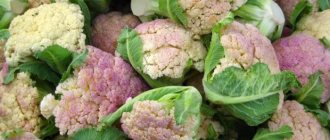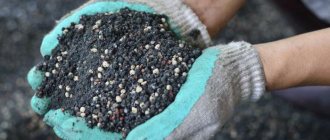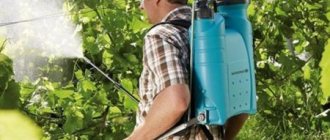The danger of frost for grapes
Spring is not only the time for plants to awaken, but also a dangerous time for temperature changes. Thus, grapes, regardless of varietal frost resistance, love warmth and suffer from cold. Therefore, many gardeners prefer to play it safe and cover their plantings for the winter, digging them out only when the temperature is stable at 8-12 °C.
During the period of revival of the vine, temperatures even at -0 degrees can lead to freezing of the eyes. And this affects both the growth of the plant and the time of flowering and the amount of harvest. If the vine is damaged by frost, the sap channels have frozen and the plant no longer receives the required amount of nutrition from the soil.
Types of frost
It is also important what type of frost came to the vineyard growing area - advective or radiation. The most dangerous is advective cooling. It is very difficult to fight it, sometimes even impossible. Such frosts are characterized by a several-day drop in temperature.
More often, the crop can withstand radiation cooling, that is, if the vines are frozen at night, then during the day they must warm up. This type of frost occurs more often at night and is concentrated at the ground level where the vineyard grows. Such frosts can and should be fought.
Symptoms of freezing
Freezing of the grapevine often worries gardeners in the spring, when active sap flow has already begun.
The vineyard can be seriously damaged by bad weather conditions, which will affect the further growth and yield of the crop. Its most vulnerable spot is its eyes. The important thing is that the replacement buds are damaged less often than those called central, the most fertile. Annual shoots also suffer from spring frosts, and in severe frosts, the roots of the plant.
You can find out whether the vineyard needs restoration in early spring. You should take a knife and make an incision on the eyes. Those buds that are not frozen will be green. Those that have a brown or brown tint are damaged. Browning of a small part of the bud indicates that the vine will move away and no measures need to be taken.
Frost damage to the root system is more dangerous. To check the viability of a culture, you should:
- Dig a small hole near the bush until the roots of the plant are exposed.
- Make a cut with a garden knife on the surface of one of the roots.
- Check the color of the structure at the cut site. It must be white. Brown or black – the plant is dead.
It is worth checking the roots only if signs of freezing of the buds are detected. Their healthy green color indicates a healthy, undamaged root system.
Ways to protect plants from frost
You can’t plant grapes in a windy place
Frost protection must be provided to the crop during the planting period. The best place for such heat-loving plants is a garden area protected from the wind. The wall of a house or some kind of outbuilding can serve as a barrier to the wind.
If you need to care for an existing plant that is not protected by a wall or other devices, you should know some features. To prevent the grapes from freezing when weather conditions worsen in the spring, you should protect them in one of the following ways:
- Use of shelters. Polyethylene film, spunbond and other materials can be used. You can build a small greenhouse where the bushes are grown by stretching the material used on trellises from different sides. You can also make a removable folding greenhouse on a wooden frame or on arches. Shelters are especially necessary in regions where the risk of frost is highest. Only when it is warm outside (at least 10°C) can you dig the bushes out of their shelter, shake off debris and soil particles and straighten them. This must be done to ventilate the plant. On the same day, before the onset of a cool night, you should build a mini greenhouse where the bush will be reliably protected from any frost. It is most effective to use a mini-greenhouse on arcs. Such a shelter allows you to leave a large space in the greenhouse, which will save the plant from overheating.
- Smoke. It is necessary to provide thick smoke that will warm the plants. You can use special smoke bombs or make a fire.
- Abundant watering and fertilizing. Watering should be done before the temperature drops. By evaporating, the moisture will protect the plants from damage. Mineral fertilizers (except nitrogen) have the same effect.
- Sprinkling. Carried out during freezing. Freezing of the shoots occurs, which will save the plant from exposure to severe frost.
- Weather conditions should be monitored. In warm, windless weather, the greenhouse can be removed. At night, the plant should be protected.
The gardener can choose the appropriate method of protecting the shelters. It is worth remembering that greenhouses have a long-lasting and most reliable effect. The remaining methods are short-term and can only help during frosts lasting 1-2 days.
In regions where spring frosts are not uncommon, gardeners can take appropriate action in the fall. After the leaves fall, you should spray the bushes with a solution of copper sulfate. In addition to the preventive effect against pests and diseases, such an operation will affect the development time of the eyes. A plant treated with such a solution is delayed in spring awakening for 7-10 days.
Preparatory procedures
To cover the tree in the fall, remove all the fruits if they remain after the assembly work. Then start pruning the grapes. When forming the crown for wintering, get rid of immature, dry shoots and weeds. Next, remove it from the trellis by twisting the long vine and tying it with twine. To reduce the risk of rot, treat the plant with a solution of copper sulfate.
A few days before covering the crop for the winter, water the plantings generously - the moist soil will withstand the cold due to the evaporation of water, which will warm the root system for some time.
Earthen shelter
This method is the most common among summer residents.
- dig grooves along the shoots 20 cm deep: making deep ditches is not necessary, earthen embankments will be enough;
- carefully place the branches in the ditch and cover them with earth;
- the height of the soil should not exceed 40 cm: if the height is below the optimal value, the eyes will freeze out over the winter.
Slate covering
Burlap is useful for wrapping vines
In order to prevent erosion of the soil embankment, gardeners use slate, an inexpensive material used to insulate plantings.
Cover the vines collected in bundles with dry leaves, hay, or wrap them in burlap. Place slate slabs on top of the protective layer. To prevent slate slabs from falling, secure them with stones or bricks; if desired, secure the material with earthen embankments.
Covering grapes with wooden shields
Using wooden panels in gardening is somewhat more difficult than the methods described above. You yourself will have to put together shields from wooden boards or boxes.
The outer side is covered with roofing felt (hammer it in or simply cover it on top after installing the structure). By giving preference to structures of this type, you will provide your garden with reliable shelter for many years.
Before installing the shields, perform the initial preparation of the plant by wrapping its branches with burlap or covering it with earth.
Do not forget to protect the ends of the structure from strong winds. Plywood or remnants of roofing felt are perfect for this.
Covering grapes with film
The design with film is identical in properties to greenhouses. Place wire arcs along the neatly folded shoots and stretch the film over them. It can be secured using stones or special weights. Before covering the plant with film, liberally apply organic fertilizer on top of the branches.
It is important to leave gaps, otherwise the plant will dry out and begin to rot, which is equal to the death of the grape tree.
Restoring frozen bushes
Fruiting eyes and annual shoots are the first to suffer from frost. Provided that the root system was not damaged by spring frosts, the bush can be restored.
If the root system is slightly damaged, gardeners recommend removing most of the vine, leaving only the root trunk with the first eye from the ground. It should be buried in the ground for 1-2 weeks so that the healthy part of the roots begins to produce layering. This method will save the vineyard, but you will have to wait several years for the next harvest. For faster recovery of the plant, it is recommended to water it frequently.
It’s easier if only some parts of the bush are damaged. Don't worry. With the beginning of sap flow, some spare buds will give rise to young shoots. Within a month, new shoots will appear and leaves will begin to form. Those shoots that remain unchanged should be pruned.
If the grapes show no signs of life, you should get rid of them. Such a plant cannot be restored.
Related article: The influence of sulfitation on the taste of wine - Operations common to various methods of wine production
Frost resistance and winter hardiness
The concepts of winter hardiness and frost resistance differ from each other. In the first case, they mean the plant’s immunity to bad weather conditions in winter. And in the second - how well the vine tolerates sub-zero air temperatures.
To improve winter hardiness, some of the shoots are removed in August and the vines are waited until they are fully ripe. For the winter, grapes must be insulated. Shoots whose length does not exceed 2 m retain their viability better. Therefore, the grapes are not watered abundantly or fed, so as not to provoke long-term and intensive growth. The last time the vines are irrigated abundantly is in August.
Be sure to improve the winter hardiness of annual and biennial specimens. Such plants must be covered for the winter. The circle around the trunk must be covered with earth, and in winter the fallen snow must be covered. To get rid of dew roots, holes are made. This measure strengthens deep-lying roots.
Non-fruiting specimens are not watered or fertilized in August. The rest are harvested before frost arrives.
What kind of frost can grapes withstand?
How much frost a bush can withstand in winter depends not only on the variety. The older the vine and the better it has ripened, the more easily it can withstand severe frosts. The roots of the plant are more sensitive to frost.
Interesting! Sick plants, as well as shrubs that did not receive enough nutrition and water during the growing season, are more susceptible to low temperatures.
At what temperature does the bush freeze?
When the soil freezes deeply, the root system dies; this happens even at temperatures slightly below -10°C. But careful insulation of the surrounding area is not enough - the young vine and buds will feel normal without shelter only at temperatures above -18°C. If the frost gets stronger, they will not survive. The old vine will easily survive -25°C, but then it will have a bad time. It turns out that if severe frosts are expected in winter, it is important to cover not only the root system, but also the above-ground part of the plant.
To understand at what sub-zero temperature grapes freeze, it is enough to know the abilities of a certain variety and control the supply of nutrition throughout the growing season.
Why does freezing occur?
The plant can freeze even in spring, when frosts unexpectedly set in after a thaw. If the minus period comes suddenly, there is a much greater likelihood of damage to the vine.
Important! Young bushes require more careful shelter; they are especially susceptible to cold temperatures and weather conditions.
Freezing threatens with insufficient watering during the growth period and before shelter. The bush must receive the necessary nutrition that will help it survive the winter. The upper part of the bush is able to grow again if the vine freezes, but the root dies forever due to frost.
The importance of timely opening of grapes
The question of when to open the grapes is indeed very important. Early dehiscence can damage young kidneys. The grapevine does not tolerate late frosts. For shoots, a temperature of -1 degree is fatal, and the buds die at -2 degrees below zero. This will not lead to the death of the plant due to the property of regeneration, but the shoots will be sterile.
The grapes are crying after pruning, what to do?
Also, a plant damaged by frost is significantly behind in development, falling behind the schedule of the growing season, which will lead to a very late harvest from the affected buds. The taste of the grapes will be significantly lower.
But you also can’t delay opening the vine. When using film as a shelter, you need to be wary of the greenhouse effect and the dissonance of air and soil temperatures, which warms up much more slowly. Such a stressful situation will lead to the wild development of greenery, which, after belated opening, will die or break off.
Attention! High temperature and humidity under the film are an excellent environment for the development of fungus, rot and other infectious diseases that cause enormous harm to grapes.
Period of the procedure
The grapes are frozen, what should I do? It is impossible to name the exact dates when the covering layer should be removed. This completely depends on the climatic conditions of the region. In one area in March there is no longer frost and warm weather sets in, and by May the leaf is already fully formed, while for others the last month of spring is the period of frost retreat. Therefore, it is impossible to give precise advice here, but there are some universal aspects that will be discussed below.
Regardless of the region, snow drifts must be removed from the vineyard in March. Next, you need to act strictly according to the weather. It is best to wait until the buds on the trees swell and the average daily temperature reaches 10 degrees above zero. The soil should be well dry by this time.
Important! In warm regions, grapes begin to open at the beginning of April, and in the northern regions, favorable weather sets in only at the end of May. Until this point, there is a high probability of return frosts.
Wilting of grapes and frosts in spring are really dangerous, but it is possible for young bushes to freeze under cover. In this case, you need to make sure that the root is alive and wait a few more weeks, feeding it with growth stimulants and biological preparations: perhaps the root system will produce new shoots and the plant can be restored.
Trellis for grapes
When to cover a bush
If in the region the temperature drops to -16°C, it is imperative to cover the plant. Even if these periods are short-lived, especially if the variety is sensitive to cold. Frost-resistant species do not cover or use semi-cover.
If the air temperature approaches zero degrees, then it’s time to start equipping a shelter. When the air drops below -5°C, the buds may already suffer, especially on young vines.
Specific grape cover numbers depend on the growing region. You shouldn't keep it open for too long. In the southern regions, shelter may not be needed at all, or a light version of insulation will be sufficient. In colder areas, winter preparations should begin as early as mid-September.
Important! It is best to insulate the bush before snow falls, at an air temperature of at least 0°C.
While there is no frost, the vine is more flexible, it can be folded in the desired direction; after frost sets in, the branches become fragile and it is difficult to direct them to the intended place. Creating a shelter will become problematic.
If you choose the right time during the onset of cold weather, the bush will be covered, and snow will fall on top of it, which will provide additional protection from frost. If a large amount of snow falls in the region (more than 50 cm), simply digging up the vines is enough.
Answers to frequently asked questions
What is the best way to cover grapes for the winter?
The best option is a combination of natural ecological cover made of grass, sawdust, foliage and agrofibre.
When should the procedure be performed?
It's different in different regions. On average - after the first frost.
Do I need to add snow?
Necessarily. It is advisable to do this several times during the winter. Snow is a natural shelter for plants from frost.
What height should the shelter be?
Not less than 15 cm. The rest depends on the chosen method of carrying out the procedure.
Do I need to prune grapes for the winter?
Mature plants are pruned according to the selected pruning pattern. For young specimens, the tops of the shoots are lightly pruned for lignification.
How to protect a plant from spring frosts
Spring frosts are the most dangerous. They usually come unexpectedly, while many winegrowers have already removed the cover from the grapevine. So what kind of frost can grapes withstand without shelter in the spring? When the temperature drops below -10°C, the bush may freeze.
Attention! For this reason, it is better to use the ground to cover the grapes, then in the spring you will not need to open the bush so early.
If the bush was covered with film or other material for the winter, then when it gets warm it can overheat inside the shelter, which means it should be opened urgently. In this case, you will have to take care of the plant in the event of a possible cold snap and provide protection from frost. The winegrower will have to constantly monitor the messages of the hydrometeorological center.
Common mistakes
Let's look at some mistakes and bad decisions that summer residents make when covering grapes for the winter.
- The plant is insulated until the first frost. This is rather a flaw. Grapes “hit” by frost taste better.
- The vine is insulated after rain until frost. But this is a serious mistake, due to which the shoots are damaged. In general, such a mistake can lead to the death of the bush.
- The grapes overwinter with leaves on the shoots. All foliage in front of the shelter must be torn off.
- Moisture charging is not carried out.
- The vines are not pruned.
- The shoots are tied and laid out sloppily. Some of the stems break.
- The vine is placed on bare ground.
How to perform a cover
Before the onset of frost, all branches of the grape bush should be removed from the support, after which the plant and its roots should be protected. Depending on the method of protection, certain materials will be required.
Semi-covering method
Incomplete coverage is used in warmer climates. These can be considered those zones where the winter temperature does not fall below -15°C. Use improvised means for this method, suitable:
A cocoon is formed from the found material around the bush; the thickness of its walls should be at least 3 cm. In this case, the bush vine should be tied with twine.
Attention! Be sure to pay special attention to the roots of the plant. To do this, the near-root part is hilled up, distributing straw or other material on top.
Full Cover
Covering the grapes completely and thoroughly preparing for frost will require more effort. Covering should begin after all the leaves have fallen from the bushes; in case of unexpected cold weather, remove the leaves yourself.
During the period of shelter there should be dry weather:
- Carefully dig up the soil around the roots of the bush without damaging them, while forming a depression in the form of a trench.
- Line the bottom of the pit with spruce branches, sawdust or other natural insulation.
- Place the bush vine on top of the spruce branches in the trench. If severe frosts are expected, the branches can be additionally wrapped in spunbond.
- The branches are covered with dry soil, possibly with the addition of humus. The entire area above the roots must be thoroughly covered.
- Lastly, be sure to create a small mound above the bush; using an additional layer of sawdust above the trench is encouraged.
If you approach the process carefully, the plant will overwinter well.
Important! If there is a danger of damage by rodents, then poison can be placed in the trench next to the vine.
Features of grape shelter in the regions
Each region of our country, as well as Ukraine and Belarus, has its own characteristics of wintering grapevines. They are related to the choice of materials, its availability and quality characteristics.
How to cover grapes for the winter in the Moscow region and Leningrad region
Moscow summer residents begin preparing grapes for winter in early September. Watering and treatment against diseases and pests is carried out immediately after harvesting the fruit clusters. By the end of September, the vine remains without leaves and is ready for winterization. In the Moscow region and Leningrad region, grapes are insulated using the trench method and dry shelter. Growing shoots are tied and laid on wooden boards or sawdust, covered on top with a large amount of spruce branches and branches that have good air conductivity. Then a frame is installed, covered with board or metal flooring in the form of a house (so that moisture does not collect).
Insulation of grapes using wooden panels is practiced in the Moscow region
How to cover grapes for the winter in central Russia
All the methods discussed above are excellent for the Central Black Earth regions of Russia and the Volga region. You can insulate grapes using oilcloth, roofing felt, synthetic materials, and using improvised means (straw, spruce branches, sawdust, foliage, grain husks, branches).
Video: a budget option for covering grapevines in Central Russia
How to cover grapes for the winter in Ukraine
On Ukrainian soil with a warm, humid climate, winter-hardy grapes often survive the cold without shelter. In the east of the country, grapevines are insulated using frame panels made of wood and slate, using the trench method - simply bending the vine to the ground and covering it with soil. The worst thing for grapes is unexpected warming, during which the buds can wake up and sap flow begins. Therefore, the most important point is to start insulation on time and not to rush to cover the grapes even in November, if the “Indian summer” has lingered outside.
Video: how grapes are insulated in Ukraine
How to cover grapes for the winter in Belarus
From the end of October, Belarusians begin to prepare grapes for winter; the protective frame is installed only with the onset of frost - mid-to-late November. A dry insulation method is used . Agrofibre, spunbond and synthetic felt are chosen as shelter; the top is covered with oilcloth or slate to protect from precipitation. To prevent the buds from getting wet during winter thaws, and to prevent high humidity from contributing to the formation of mold and rot, it is necessary to leave vents on the sides of the shelter for reliable ventilation. Here they consider the main problem when wintering in a vineyard to be damp.
Video: grape shelter in Belarus
How to cover grapes for the winter in Siberia
The harsh climate of Siberia requires reliable shelter for a heat-loving crop. Therefore, the grapes are hidden in deep trenches, with wooden flooring or pieces of brick placed underneath. The shoots are covered closely from above with lutrasil and covered with burlap. The main insulation is spruce branches, sawdust, and earth poured on top, protected by metal sheets or slate. The main source of heat retention is snow (a layer of at least 50–60 cm). Be sure to carry out treatment against rodents and leave small vents for ventilation.
Video: winter shelter for grapevines (for Siberia)
Saving frozen bushes
If a sheltered shrub has been exposed to frost or has not been insulated and prepared for winter at all, then it can be saved, but only if the roots are intact. A healthy root will produce a new vine and produce a harvest in a few years, and the bush itself will live. The situation is worse when the roots are frozen; nothing can help.
What to do if bushes are damaged
In the event that it was not possible to cover the grapes and the vine was damaged, measures will have to be taken to save the bush. To make it easier for the plant to survive the injury, you need to help it, for this:
- begin the formation of the vine again, leaving only two powerful shoots, and remove the rest;
- if inflorescences have formed, it is better to remove them;
- if the bush begins to actively grow, then at the end of summer you should pinch the shoots, this procedure will accelerate the ripening of tissues;
- Prune in the fall.
After the rescue procedure, be sure to cover the bush for the winter to help it recover.
With the right approach, grapes will produce a large and tasty harvest, regardless of the variety. It is worth taking a more responsible approach to choosing a variety, taking into account regional characteristics and the resistance of the species to frost.
Related article: How to get a grape harvest in the year of planting
Resistance of grapes to frost and frost
Contents of the material
I. N. Kondo GRAPES RESISTANCE TO FROST AND FREEZING 1 Sharp reductions in grape yields to a minimum level in many places of its cultivation are often caused by damage to the vineyards by frosts and frosts. Therefore, the issues of frost and winter hardiness of grape plants are very relevant for all viticultural regions of the globe located in the continental climate zone. The resistance of perennial plants to frost throughout the annual cycle of their development does not remain constant, as is known, but varies greatly depending on many factors, and, in particular, on external conditions, the physiological state of the plant organism, the direction and nature of metabolism in its organs and fabrics. Frost resistance is most weakly manifested in the warm season, during the period of intensive plant growth; it is most strongly expressed during the period of relative dormancy of plants after the onset of a stable autumn cold snap and the subsequent gradual decrease in autumn-winter temperatures. The results of overwintering grape bushes are significantly influenced not only by the meteorological features of the autumn and winter months, but also by the growing conditions of plants during the growing season. By regulating, with the help of appropriate agricultural practices, the intensity and nature of plant growth, it is possible to have a great influence on the timing and rate of passage of the growing season phases, on the timing and degree of completion of growth processes, on the productivity of bushes, on their preparation for wintering, and, ultimately (in what - least), on their resistance to frost. However, the decisive role in preparing plants for overwintering belongs to the thermal conditions that develop in the period preceding the onset of dangerously low temperatures and determining their physiological state at the time of exposure to frost. From the entire complex complex of physiological processes occurring in the body of a grape plant at the end of summer and during autumn, the following three processes can be distinguished, the passage of which is directly related to its preparation for wintering:
- modern cessation of growth of shoots in length and thickness and the stay of overwintering buds and cambium in a state of organic dormancy;
- ripening of shoot tissues;
- hardening of the plant organism in relation to low temperatures, i.e. developing in it the ability to successfully withstand the harmful effects of critical negative temperatures.
The entry of buds into a dormant state and the ripening of plant tissues—these two processes coincide in time at a certain period during the preparation of plants for overwintering and proceed in parallel. The hardening process is successful only if the shoots are fully matured and all meristematic tissues of the above-ground plant organs (buds and cambium) capable of growth have entered a dormant state.











